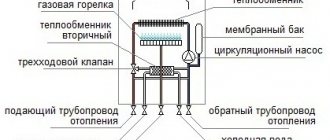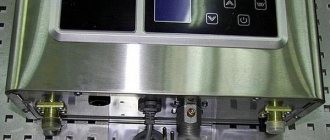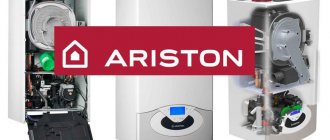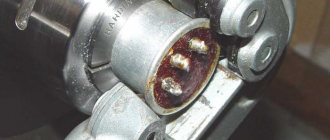Here you will learn:
- The most common causes of breakdowns
- Elimination of traction disorders
- Water pressure problem
- Problems with insufficient gas pressure
- Problems with ignition
- Problem with clogs
- Removing burner blockage
- Gas block and membrane repair
- Mixing cold water in the mixer
- Electronics malfunction
- Finally
Your gas heater won't light and you want to call a technician? We assure you that many malfunctions and breakdowns can be dealt with on your own, without the help of specialists. And the simpler the geyser, the easier it is to repair it. In this review, we will not only talk about the malfunctions, but also give recommendations for eliminating them - after which you will be able to light up your speaker .
The most common causes of breakdowns
Let's start a review of breakdowns using the example of such simple geysers as Oasis or Neva. These are fairly simple devices, so almost any man who knows how to work with tools and has relatively straight hands can handle their repair. Here is a short list of possible faults and causes:
- Lack of traction;
- Insufficient water pressure;
- Insufficient gas pressure;
- Inoperative ignition system;
- Clogged tubes and water supply filter;
- Burner clogged;
- Malfunction of the membrane or gas block;
- Inaccurate mixing of cold water in the mixer;
- Faulty electronics or sensors.
Now we will look at how to eliminate breakdowns and causes of lack of ignition.
Elimination of traction disorders
To test traction, try using an ordinary match. Bring it to the chimney and determine if there is a draft, then the flame will deviate towards the chimney.
If there is no draft, the gas water heater will not light and users will not receive hot water. Many dispensers are equipped with draft sensors, and if they show insufficient draft, ignition will be impossible. Situations are possible when the flame lights up and immediately goes out - this is due to the fact that the combustion products simply have nowhere to go, they remain in the combustion chamber, and the flame goes out due to lack of oxygen. Lack of draft will require an inspection of the flue gas collector and the chimney itself. If there are blockages here, they can interfere with the normal passage of combustion products. The column perceives this as a lack of traction and does not allow the gas to ignite (or the gas goes out immediately after turning on). Unfortunately, you will be able to independently check only the part of the chimney that is visible before entering the wall - further work must be carried out by specialists . If the house is private, you can try to figure out the chimney yourself.
Possible reasons why the column does not light up
A geyser is a fairly reliable device, but even the highest quality equipment can fail over time. Of course, if the conditions of proper timely maintenance are met, the column can last for many years without requiring any repairs. However, breakdowns do happen. What could be the reason that the equipment does not light up when it is turned on?
Does the column not light up when you turn it on, or does the flame just go out immediately after turning it on? The reason is the lack of draft observed in the ventilation duct. This may occur due to the fact that the channel is clogged with a foreign object or accumulated combustion products.
If there is no draft, then a special protective system in the water heater is triggered, the gas supply to the burner automatically stops, that is, the flame goes out.
You can check whether the lack of traction is the cause of such a malfunction yourself. To do this, open a window in the room where the speaker is located, light a match, or simply place your palm on the chimney opening. If there is a draft, then the flame of the match will extinguish or deviate, and the palm will immediately feel the movement of air. If this does not happen, then there is no traction. What to do in this case? Problems can be eliminated by cleaning the channel. But it is not recommended to do this with your own hands; the best thing to do is to immediately call the service organization and call a gas technician.
Another reason why the column does not light up when turned on is that the batteries for the device’s automatic ignition system are completely discharged. If we have a similar system, we must remember that the generator or batteries are discharged quite often, even if the manufacturer says that you don’t have to worry about changing them for a whole year. Practice shows that batteries are replaced much more often than once a year. Checking the battery discharge is quite simple, you just need to press the power button; if the panel does not respond, then buy new batteries and replace the discharged ones.
Water pressure problem
To clean the water filter, disconnect the cold water supply pipe. At the place where it is attached you will see a mesh filter; cleaning it will help restore the pressure.
If your gas water heater does not light up, but everything is fine with the draft, then there may be a problem with the water supply. A small pressure often leads to the ignition not working. You can try to adjust the pressure on the column itself using the appropriate regulator - sometimes this helps (although the regulator is not present in all models). also check the filter installed at the inlet of the column - it could be clogged. If there is no pressure even in a cold water tap, all that remains is to complain to the authorities responsible for water supply - the pressure must correspond to the standards established in the country. If no one is going to do anything, we install a pressure-increasing pump - it will raise the pressure to the required limits and help ignite the gas in your column. Installing a pump is a completely legal operation.
You can also check the pipes passing through the apartment/house; it is quite possible that they are clogged or rusted to such an extent that the clearance has become very small - this has a negative effect on the pressure.
Problem with traction
If the chimney is clogged with soot or debris, the exit of combustion products is complicated. The following threats arise:
- Carbon monoxide returns along with the air into the apparatus and extinguishes the burner. The column's defense is triggered, stopping its operation.
- The situation is the same as in point 1, only the return of the dangerous mixture occurs into the room. In this case, the health of the residents may be seriously affected.
The ventilation tunnel needs to be checked. A lit match is brought to his entrance.
If the fire is deflected inward, then there are no problems with draft. In another case, prompt measures are required:
- Checking the presence of an antenna above the ventilation shaft exit. Ask your neighbors to move it.
- Call specialists to cleanse this channel.
Problems with ignition
Typically, batteries in geysers are located in the lower right corner, and replacing them does not require much effort.
Situations are often observed when gas is supplied, there is draft, the pressure is normal, but the gas water heater does not ignite. If you have a Neva or Oasis gas water heater installed with electric ignition, listen to see if there is a spark being generated. The presence of a spark is indicated by a characteristic crackling sound heard when the tap is opened. If you hear a crackling sound, but the gas heater does not ignite, try replacing the batteries - this is a very common reason for the lack of ignition (a weak spark makes normal ignition impossible). Owners of speakers with piezoelectric ignition need to make sure that the igniter is working. If it lights up, then the column should light up immediately, without hesitation. If there is no flame, try to light it with the ignition button. If the gas in the igniter does not ignite, then the problem is in the igniter itself (in the nozzle) - it needs to be cleaned. To do this, we disassemble the gas water heater, get to the fuse and clean it with steel wire. Next, we try to light the column again.
When repairing your geyser, be careful and always turn off the gas supply before carrying out any operations.
As for hydrodynamic ignition, it is a combination of a small generator and an electrical circuit that generates a spark and powers some other electronic components. If the generator or circuit fails, the gas water heater will not light. Self-repair here is only possible if you have the appropriate knowledge and experience in electronics repair.
If the gas water heater does not heat the water
It happens that the column turns on properly, does not go out during operation and no popping sounds are heard, but the water still remains cold. The reasons why a geyser does not heat water vary.
Weak power
The cause of this problem is insufficient equipment power. This happens when water is turned on simultaneously in several rooms at once, and the potential of the column is not enough to process all processes. If a geyser does not heat water well, then the solution would be to buy a device with more power. As an alternative, you can alternately turn on the water supply in different rooms.
Problems during installation
This problem is diagnosed immediately after installing a new device, when the column does not light up when turned on for the first time. It indicates that the water supply hoses were mixed up when installing the parts. The problem disappears as soon as the water supply lines are installed correctly.
Problem with clogs
Filters are often installed at the entrance to the gas water heater, which filter out small solid impurities contained in the water. Salts also settle here, becoming an obstacle to the normal passage of liquid. As a result, the water heater stops lighting up and providing the household with hot water. In this case, you need to turn off the water supply, unscrew the filter and clean it. If the condition of the filter is very severe, then it is easier to replace it.
To clean the heat exchanger, soak it in a solution of water and detergent, and pour citric acid into the tubes to the top and leave for half an hour.
Also, during many years of operation of the column, the tubes or heat exchanger may become clogged. In this case, you need to check the permeability of the water unit and make sure that the heat exchanger is permeable. Blockages are removed by washing with special reagents - to purchase them, you should contact your nearest hardware store. After flushing, the functionality of your geyser will be restored.
In order to prevent sediment from clogging the inside of the column, install a decent filter at the entrance to the column, which will remove small impurities and soften hard water.
If the column is leaking
Another common malfunction is water leakage during equipment operation. It occurs for the following reasons:
- Incorrect installation of water supply hoses.
- The water part or heat exchanger has worn out during long-term operation and requires replacement.
If the problems are known, then it is necessary to apply methods to solve them:
- replacing special rubber gaskets on hoses that have come loose or worn out after long-term use;
- if the first method does not produce results, you should resort to more serious measures.
Removing burner blockage
Unfortunately, the burners in the Neva and Oasis gas water heaters (as in many others) are susceptible to blockages. Most often, this picture is observed in models with piezoelectric ignition. The cause of clogging is the accumulation of soot. It needs to be removed, for which the column is disassembled and the burner itself is removed from it. Any available tools are used for cleaning. After cleaning, the burner should be reinstalled and checked. If necessary, you can immediately clean the heat exchanger - its clogging leads to loss of traction and deterioration of heating.
If your gas heater does not light and you decide to clean it, do it on the balcony or in the open air. Otherwise, soot flying into the air will definitely stain the entire room in which the speaker is installed.
Typical geyser breakdowns and their elimination
A geyser is a fairly complex piece of equipment that, with proper care and compliance with basic operating rules, can serve its owners for quite a long time. However, any equipment breaks down sooner or later, and geysers are no exception. In accordance with the rules of safe operation, malfunctions of gas equipment should be eliminated exclusively by professional gas workers, however, there are a number of typical reasons (most often related to the fact that the gas water heater worked normally and caught fire, but suddenly stopped lighting) that can be identified and corrected independently. Knowing certain subtleties, it is quite possible to repair a gas water heater without the involvement of third-party specialists.
Diagram of a gas water heater without a chimney.
The gas water heater does not light up: possible reasons
The most common reason that a gas water heater, which previously worked normally, now does not light up, can be the usual lack of draft in the ventilation well.
It is possible that some foreign object has entered your chimney. In addition, it can simply become clogged with soot that has accumulated during operation of the unit. In such situations, a special protective system is activated, which is installed inside the unit, and the gas supply is automatically shut off in the device itself.
Check the draft in the chimney. This is quite simple to do: you need to light a match and bring it to the well. If the flame deviates towards the well, then everything is fine, there are no problems with draft. It is enough just to eliminate the cause, after which the gas water heater will light up again and work normally, that is, either clean the well with your own hands, or call the appropriate technician for this.
Diagram of the gas water heater.
Another common reason why a gas water heater won't light up could be that the batteries are low. However, this is only true for equipment with an automatic ignition system. It is noteworthy that, contrary to the assurances of manufacturing companies, which for the most part claim that the service life of replaceable batteries is 1 year, they have to be changed much more often. In order for a gas water heater to light up, in this case it is necessary, of course, to change the batteries.
If none of the above cases apply to yours and you are wondering why the column is not working as it should, check the water pressure. Very often the geyser does not light up due to insufficient water pressure. This can be checked quite simply: open the cold water tap and watch the pressure. If it is small, then the reason may not be in the column itself, but in the entire water supply system or some separate section of it.
If the cold water pressure is stronger than the pressure in the hot tap, then the reason may lie directly in the water unit of the gas water heater, for example, if the membrane is deformed or the filters are clogged. Quite often, coarse filters additionally included in the system are the cause.
To fix this problem, you first need to call the utility service to find out why there is no normal water pressure. After this, it is necessary to rinse the cleaning filters or replace them in the mixer. You can submit a request to the utility service to flush your water pipes. The column must be cleaned of soot and other combustion products. It may be necessary to replace the membrane of the water unit of the unit.
Quite often it happens that the gas water heater lights up, but does not work, and immediately goes out. In this situation, it is necessary to adjust the supply of cold and hot water. Remember not to try to dilute hot water with cold water, as this will cause the flame to go out quickly. Among other things, such actions violate the rules for operating a gas water heater.
How to flush a gas water heater?
Table of capacities of a chimneyless gas water heater.
Sometimes, in order to understand why the gas water heater no longer lights up, you need to disassemble it, and, if the reason for the malfunction of the equipment is accumulated scale, wash it. Prepare the tools needed for the job:
- Pipe wrench.
- Adjustable wrench.
- Flathead and Phillips screwdrivers.
- Set of spare paronite gaskets.
- Rubber hose (usually ½ inch) with a metal clamp.
- Descaling agent.
- Basin.
First, you need to remove the fittings (handles, etc.) from the gas water heater, and then remove the casing. Then you need to decide on the water supply pipes. Be careful at this stage so as not to accidentally touch the gas. Next, it is most often advised to remove the heat exchanger and wash it outside the column. However, you can do it differently.
Related article: The main causes of air locks in heating system radiators
After the casing is removed from the gas water heater, it is necessary to shut off the water supply at the inlet and open any of the hot water taps, preferably the one installed closest to the column. Next, you need to unscrew the supply tube from the water heater heat exchanger and move it slightly to the side. The heat exchanger is made of copper, and the tube will allow you to do this without any extra effort. As soon as the nut is unscrewed from the heat exchanger, water will begin to flow out of it - the tap is open. You don’t need to drain very much water, about 1 liter. You will find more accurate values in the instructions for your unit.
Further actions are as follows: a hose is put on the inlet of the heat exchanger, raised higher than the column, a funnel is inserted into the hose, and the prepared descaling solution is gradually poured into it in a thin stream. Pour the solution gradually, as otherwise a reaction may begin that will push the solution back. The solution contains hydrochloric acid, which can cause burns if handled carelessly. You especially need to protect your eyes.
The descaling solution must be left in the heat exchanger for about 2 hours (the exact time is indicated in the instructions for the product). If the gas has not been turned off, and it was not said that this needs to be done, you can carefully try to heat the solution on a burning igniter. As a result, the reaction will go faster and less time will be needed for cleaning.
Water consumption table for a chimneyless geyser.
You should place some kind of basin or bucket under the tap, after which you can open the water supply to the gas water heater, just do it slowly. See what comes out of the hose. If a lot of sludge comes out and the pressure increases after flushing, then everything went fine. If not, you will have to repeat washing the column again. However, if you use modern high-quality products, you most likely will not have to do this. If you have not found a suitable remedy, you can prepare its analogue yourself, for example, by mixing 100 g of citric acid and 500 ml of water.
The catch in this case is that the gas water heater contains not only a heat exchanger, but also a number of other parts. The heat exchanger itself is made of copper, and, by and large, nothing will happen to it, but the so-called. The gearbox is usually made of aluminum and can be damaged. Therefore, if you fail to find a cleaning agent specifically designed for washing and use a homemade one instead, it is better to remove the heat exchanger and wash it separately.
Of course, if you completely disassemble the heat exchanger of a gas water heater, you will have to do a lot of extra work, but this way you will be sure that you will not damage it. You can wash the flow part of a gas column that does not ignite due to blockage using other means, but you need to be careful during any experiments.
Why won't the main burner light? It also happens that the main burner of the column does not ignite, although the pilot burner is working normally. This can be caused by several factors. It is necessary to consider these causes in order of likelihood of their occurrence.
Diagram of a column burner without a chimney.
Incorrectly executed water supply. If the main burner does not ignite during the first start after installing a gas water heater, the reason for this is most likely due to incorrect connection of the pipes. To eliminate this defect, it is necessary to correctly connect the water pipes.
Damage or complete failure of the membrane. This defect can be eliminated by simply replacing the rubber membrane.
Clogging of the filter in the hydraulic group (water fittings) or clogging of the mixer screens. The problem is solved by cleaning the mixer screens or filters of the hydraulic group.
Related article: Advantages and types of wooden floors in an apartment
Inlet water pressure is not high enough. To eliminate this defect, it is necessary to increase the inlet pressure. You can try adjusting the water heater by setting it with the pressure regulator to minimum. After this, the column should work normally.
The water flow is less than the minimum allowable. To solve the problem, you need to increase the water flow.
The gas pressure in the system is less than the minimum. Solving the problem will require increasing the gas pressure. Few people know that flexible gas supply hoses significantly reduce gas pressure on the device. So, it is better not to install flexible gas hoses longer than 3 m.
The geyser goes out after a few minutes of operation
Gas water heater connection diagram.
A fairly common defect is when the geyser turns off a few minutes after it is turned on. It is characteristic that, as a rule, the ignition and main burners turn off just a few minutes after startup. So why does the gas water heater go out? The only option is an emergency operation of the flue gas sensor, which, in fact, opens the thermocouple. Another option, but extremely unlikely, is that the sensor itself breaks down, but if its resistance is infinity, then everything is fine with the sensor.
If the gas heater goes out, you need to check the chimney. The emergency operation of the previously mentioned flue gas sensor indicates that gases are removed very poorly or not removed at all. And this is fraught with carbon monoxide poisoning. The damage is quite serious. The first thing you need to do is check the chimney. Moreover, it is better if specialists do this. However, until a specialist from the relevant organization arrives, you can check on your own whether one of your neighbors has installed a satellite dish on the chimney, because This equipment may interfere with the normal operation of the chimney. The installation of satellite dishes on chimneys is prohibited.
The flue gas sensor can also be triggered if a high-power hood is installed in the same room as the gas water heater, which forces the flue gases to be removed in a manner not intended, i.e. through the chimney, but directly into the room. It is strictly prohibited to install geysers and hoods in the same room.
The geyser goes out after releasing the ignition button during switching on
The principle of operation of a gas water heater.
If the gas heater goes out (the pilot flame goes out), then the reason, first of all, may be that you did not hold the ignition button long enough. The ignition button must be held for about 20 seconds.
The column may also go out due to a breakdown of the exhaust gas sensor. To check the functionality of the flue gas sensor, you need to disconnect the wire terminals of this sensor and ring it. The resistance of a normally operating sensor should be equal to infinity. If this is not the case, the sensor should be replaced.
The pilot burner may also go out due to a broken thermocouple. To determine whether the thermocouple is faulty, disconnect the sensor terminals and measure the thermocouple voltage with the igniter pressed. The voltage should not exceed 10 mV.
The pilot burner flame may also go out due to a breakdown of the solenoid valve, the work of which is best left to a qualified specialist.
Why doesn't the pilot burner flame light up?
Water pressure diagram.
If it is not possible to ignite the flame of the pilot burner when the column turns off without starting, there may be many reasons for this. The following will list the possible causes of such a breakdown in order of increasing likelihood of their occurrence.
The cause of such a defect may be a closed gas valve. To fix the defect, you just need to open it.
The next reason is that the gas fittings of the column and the gas pipeline are air-filled. A characteristic sign of this malfunction is a whistle from the pilot burner nozzle. To eliminate the defect, unscrew the nut securing the pilot gas tube to the fitting. After this, press the ignition button on the gas valve, then bleed the air until the characteristic smell of gas appears. After supplying gas, the tube must be tightened.
Another possible cause is flame separation. A sign of this defect is a characteristic whistle from the burner nozzle. In this case, you need to try to adjust the gas pressure on the burner using the screw. In addition, the cause of flame separation may be the installation of an incorrect nozzle that is not designed for this type of gas. The problem can be solved by replacing the injector.
Related article: Do-it-yourself ceiling made of plastic panels - instructions (photos and videos)
And another possible reason is the entry of dirt or a foreign object into the gas supply path from the fittings to the pilot burner. A sign of this defect may be the absence of a whistle. To eliminate the defect, it is necessary to clean the nozzle or gas burner. If cleaning is impossible, the defect can be eliminated by replacing the gas fittings.
Lost Spark: Causes and Possible Solutions Loss of spark is one of the most common causes of gas water heater failure. If a spark does not appear when you press the button, the causes of this malfunction may lie in the lack of contact between the current-carrying wire and the piezoelectric element. If contact is present, then the fault must be looked for directly in the piezo ignition button. You can verify that this button is working properly by bringing the opposite end of the current-carrying wire closer to the speaker body. If after a click a spark appears on the body, the piezo ignition button works normally.
If a spark is present, but not at the igniter, then the cause of this defect may be a malfunction of the current-carrying wire. If necessary, the wire should be changed. Such a malfunction can also be caused by damage to the ignition electrode.
Other common malfunctions A malfunction such as lack of ignition is often accompanied or is a consequence/cause of other malfunctions that you also need to be aware of.
For example, pops and micro-explosions that accompany the switching on of the equipment can occur due to insufficient draft in the ventilation duct due to a clogged nozzle or other elements of the water heater, due to the discharge of the ignition batteries of the equipment, or due to too strong an influx of gas. To eliminate this malfunction, you need to clean the chimney, for which you should call the utility service and call a chimney sweep, or replace the batteries. In all other cases, it is better to contact specialists to solve problems.
Remember also that when you turn on the gas water heater, you should not hear the characteristic smell of gas. If there is one, you must immediately turn off the gas valve and ventilate the room very thoroughly, after which you must call the gas service. Under no circumstances should you try to fix such a breakdown yourself.
When the gas water heater turns on, a characteristic sound must be heard. So, if the unit simply does not want to ignite, listen and try to understand whether gas is flowing. If there is no characteristic sound, we can conclude that gas is not flowing. This defect can be resolved by calling the gas utility or utility service. You need to ask if any repair work is currently being carried out on your site. If no work is carried out, you must call a gas technician.
And the last common malfunction may be that the equipment lights up, but does not heat the water or heats it very poorly. There may be several reasons for this. First of all, the situation may develop this way due to the low power of the equipment, to clarify which you should refer to the passport of the unit installed in your home, study its technical characteristics, etc.
In addition, the water may not heat up well enough due to the usual blockage of the water heater, a sign of which is a change in the color of the flame and the appearance of soot under the column during operation.
The water will not heat up well even if the gas supply pressure is low (insufficient).
To solve this problem, you need to try adjusting the hot water tap. If this does not make any difference, you will need to call a technician, call the gas service, or try to clean the column yourself. Cleaning instructions have been provided above.
This is the entire list of possible typical geyser failures that you can fix yourself. However, if you are not completely confident in your own knowledge regarding the design of this unit, or if you do not have the appropriate tools to repair the geyser yourself, it is better to address this issue to professional, experienced and qualified craftsmen.
Gas block and membrane repair
To replace the membrane, remove the column water block. After disassembling it you will get to the membrane.
Sometimes a geyser does not ignite due to damage to the membrane - it reacts to water pressure and controls further ignition. If it is torn, then further operation of the gas water heater will be impossible. Difficulties in repair will be caused by the fact that it is difficult to find a suitable membrane - they are rarely found on sale, and their prices are high. In addition to the membrane, you need to check the entire gas block, since it is full of parts that can fail.
To disassemble and repair the gas block, detailed instructions may be required - they can be found on our website or on the Internet.
Troubleshooting that prevents the gas heater from igniting
There is a turbocharged gas water heater with electric ignition. When the hot water is turned on, the heater clicks, but does not light up. An electric discharge is heard and the fan turns on.
The first step is to carry out an inspection; to do this, remove the column cover. It is fastened with four bolts: two from below, two from above. We also remove the knobs for adjusting the flame, temperature, and winter-summer mode. Upon inspection, everything seems intact, the wires are not burned anywhere, water is not leaking anywhere.
The principle of operation is that when a water flow appears, the gas valve is activated, an electric discharge is created, the gas is ignited, and at the same time the fan is turned on to draw waste combustion products outside. If the water pressure is insufficient or the hood does not work, the gas goes out and the column turns off.
So, open the tap and see what happens. Water rustled through the heat exchanger tubes, the electrodes gave a discharge, the fan turned on, but the gas did not ignite. Let's check if the relay (microswitch) is working, which is activated when there is sufficient water pressure and opens the gas supply valve. To do this, turn the tap again, the relay tongue should move away.
It works, which means the pressure is sufficient for the gas water heater to operate. Now let's check the operation of the gas valve. To do this, use a screwdriver to move the same tongue away without opening the water. If there is a spark at the electrodes and the fan starts working, then the gas valve is working.
The fault was found quite quickly; the ignition electrode did not produce a spark. There are only two of them: extreme ones. The one in the center is the control one; if there is no flame, it turns off the gas supply.
Mixing cold water in the mixer
Many people, instead of adjusting the degree of heating on the gas water heater itself, mercilessly torment the mixer. If you open the cold water too much, the lit column will simply go out. If at that moment it was not burning, then it will certainly not catch fire. Make it a rule to turn on the hot water supply first, and only then the cold water supply. It’s best to adjust the degree of heating using the appropriate controls.
You also need to remember that intensive mixing of cold water is not welcomed by the developers of geysers - this can lead to their damage.
Electronics malfunction
The draft sensor in geysers is usually located on top. It is attached to the chimney.
Modern geysers have many electronic units and sensors on board - only the simplest models do not have them. Sensors monitor draft and the presence of flame (ionization control), monitor the water temperature and automatically regulate the degree of its heating. If one of the sensors fails, the gas water heater will malfunction. The most typical malfunction is a breakdown of the draft sensor in the exhaust gas manifold. As a result, the electronics will not give the go-ahead for ignition. Failures also occur in electronic modules installed in many geysers. Repairing them is complicated by the fact that this requires special knowledge in the field of electronics and circuit design. If you are sure that electronic components are faulty, but do not have the necessary knowledge, feel free to call a specialist.











